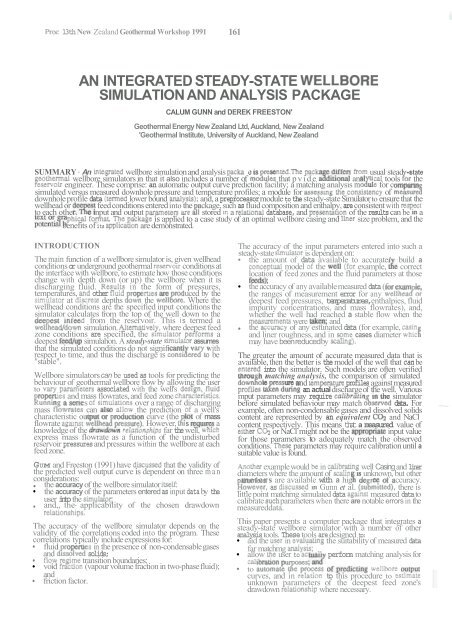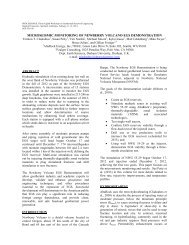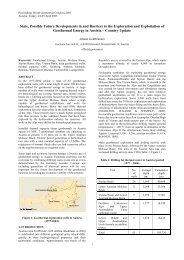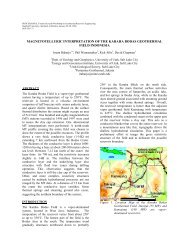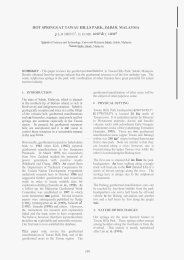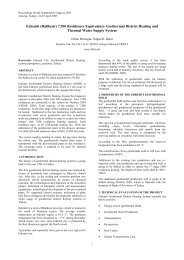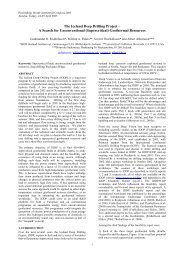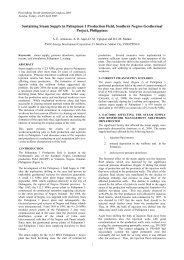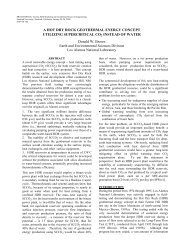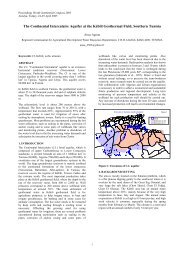an integrated steady-state - International Geothermal Association
an integrated steady-state - International Geothermal Association
an integrated steady-state - International Geothermal Association
You also want an ePaper? Increase the reach of your titles
YUMPU automatically turns print PDFs into web optimized ePapers that Google loves.
13th New Zeal<strong>an</strong>d <strong>Geothermal</strong> Workshop 1991 161<br />
AN INTEGRATED STEADY-STATE<br />
SIMULATION AND ANALYSIS PACKAGE<br />
CALUM GUNN <strong>an</strong>d DEREK FREESTON'<br />
<strong>Geothermal</strong> Energy New Zeal<strong>an</strong>d Ltd, Auckl<strong>an</strong>d, New Zeal<strong>an</strong>d<br />
'<strong>Geothermal</strong> Institute, University of Auckl<strong>an</strong>d, New Zeal<strong>an</strong>d<br />
SUMMARY An wellbore simulation<strong>an</strong>d <strong>an</strong>alysis e is usual stead -<strong>state</strong><br />
wellbore simulators in that it also includes a number of that pvide <strong>an</strong>al tools the<br />
engineer. These comprise: <strong>an</strong> automatic output curve prediction facility; a matching <strong>an</strong>alysis m for comparin<br />
simulated versus measured downhole pressure <strong>an</strong>d temperature profiles; a module for<br />
of<br />
downholeprofile data lower bound <strong>an</strong>d, a preprocessormodule to the <strong>steady</strong>-<strong>state</strong>Simulator to ensure that the<br />
wellhead or feedconditions entered into the ackage, such as fluidcomposition <strong>an</strong>d enthalpy, are consistent with<br />
to each other. e input <strong>an</strong>d output stored a database, <strong>an</strong>d of the results c<strong>an</strong> be a<br />
is applied to a case study of <strong>an</strong> optimal wellbore casing <strong>an</strong>d size problem, <strong>an</strong>d the<br />
benefits of its are demonstrated.<br />
INTRODUCTION<br />
The main function of a wellbore simulator is, given wellhead<br />
conditions or underground geothermal conditions at<br />
the interfacewith wellbore, to estimatehow those conditions<br />
ch<strong>an</strong>ge with depth down (or up) the wellbore when it is<br />
discharging fluid. in the form of pressures,<br />
temperatures, other are uced by the<br />
at depths the Where the<br />
wellhead conditions are the specified input conditions the<br />
simulator calculates from the top of the well down to the<br />
dee est from the reservoir. This is termed a<br />
simulation.<br />
where deepest feed<br />
zone conditions are specified, the<br />
a<br />
deepest simulahon. A <strong>steady</strong>-<strong>state</strong> assumes<br />
that the simulated conditions do not signific<strong>an</strong>tly v with<br />
respect to time, <strong>an</strong>d thus the discharge is<br />
be<br />
"stable".<br />
Wellbore simulatorsc<strong>an</strong> be used as tools for predicting the<br />
behaviour of geothermal wellbore flow by allowing the user<br />
to<br />
associated with the well's<br />
<strong>an</strong>d mass flowrates,<strong>an</strong>d feed zone<br />
a series over a r<strong>an</strong>ge discharging<br />
mass c<strong>an</strong> the prediction a well's<br />
characteristic output or roduction curve (the of mass<br />
flowrate However, s a<br />
knowledge of the<br />
far the well,<br />
express mass flowrate as a function of the undisturbed<br />
reservoir pressures <strong>an</strong>d pressures within the wellbore at each<br />
feed zone.<br />
GUM <strong>an</strong>d Freeston (1991) have that the validity of<br />
the predicted well output curve is dependent on three m<strong>an</strong><br />
considerations:<br />
the accuracy of the wellbore simulator<br />
the accuracy of the parameters entered as input data by the<br />
user intothe<br />
<strong>an</strong>d,, the- applicability of the chosen drawdown<br />
The accuracy of the wellbore simulator depends on the<br />
validity of the correlations coded into the program. These<br />
correlations typically include expressions for:<br />
fluid in the presence of non-condensable gases<br />
<strong>an</strong>d solids;<br />
tr<strong>an</strong>sition boundaries;<br />
void (vapour volume fraction in two-phasefluid);<br />
<strong>an</strong>d<br />
friction factor.<br />
The accuracy of the input parameters entered into such a<br />
<strong>steady</strong>-<strong>state</strong> is dependent on:<br />
the amount of data available to accurate1 build a<br />
model the example, correct<br />
location of feed zones <strong>an</strong>d the fluid parameters at those<br />
the accuracy of <strong>an</strong>y availablemeasured data (for exam le,<br />
the r<strong>an</strong>ges of measurement error for <strong>an</strong>y<br />
deepest feed pressures, temperatures,enthalpies, fluid<br />
impurity concentrations, <strong>an</strong>d mass flowrates), <strong>an</strong>d,<br />
whether the well had reached a stable flow when the<br />
were <strong>an</strong>d<br />
the of <strong>an</strong>y estunated data (for example,<br />
<strong>an</strong>d liner roughness, <strong>an</strong>d in cases diameter<br />
may have beenreducedby<br />
The greater the amount of accurate measured data that is<br />
available, then the better is the model of the well that c<strong>an</strong> be<br />
into the simulator. Such models are often verified<br />
h matching <strong>an</strong>alysis, the comparison of simulated<br />
<strong>an</strong>d<br />
profiles againstmeasured<br />
<strong>an</strong> actualdischargeof the well. Various<br />
mput parameters may require<br />
in the simulator<br />
before simulated behaviour may match data. For<br />
example, often non-condensablegases <strong>an</strong>d dissolved solids<br />
content are represented by <strong>an</strong> equivalent <strong>an</strong>d NaCl<br />
content respectively. This me<strong>an</strong>s that a measured value of<br />
or NaCl might not be the input value<br />
for those parameters to adequately match the observed<br />
conditions. parameters may require calibration until a<br />
suitable value is found.<br />
examplewould in well Casing <strong>an</strong>d liner<br />
diameterswhere the amount of unknown, but other<br />
meters are available with a hig de of accuracy.<br />
as Gunn et al. there is<br />
little pomt matchmg simulated data measured data to<br />
calibrate suchparameters when there are notable errors in the<br />
measureddata.<br />
This paper presents a computer package that integrates a<br />
<strong>steady</strong>-<strong>state</strong> wellbore simulator with a number of other<br />
<strong>an</strong>alysis tools. These tools are designed to:<br />
aid the in the suitabilityof measured data<br />
far matchmg<br />
allow user to perform matching <strong>an</strong>alysis for<br />
p<br />
to<br />
curves, <strong>an</strong>d in to this procedure to<br />
unknown parameters of the deepest feed zone's<br />
drawdown where necessary.
162<br />
Although the e c<strong>an</strong>not in itself address concerns about NaCl or content values to be entered into the simulator.<br />
the a particular drawdown it<br />
the user with a choiceof such relahonshipsto apply.<br />
The result<strong>an</strong>t lower bound profiles c<strong>an</strong> be displayed<br />
Lower bound <strong>an</strong>alysisis described in<br />
Gunn et al. (submitted).<br />
pre of e is of <strong>an</strong> ongoing study<br />
it is to extend the<br />
scope of the package to include the of tr<strong>an</strong>sient<br />
STEADY-STATE SIMULATION FEATURES<br />
effects.<br />
The module of the packa e is the <strong>steady</strong>-<strong>state</strong> simulation<br />
SIMULATION AND ANALYSIS MODULES<br />
includes the<br />
features.<br />
liquid, two-phase, <strong>an</strong>d superheated steam flow.<br />
The packa e includes five main simulation <strong>an</strong>d <strong>an</strong>alysis<br />
Incorporates dissolved solids content by <strong>an</strong> equivalent<br />
modules, are as follows.<br />
percent of NaCl.<br />
non-condensable gas content by <strong>an</strong><br />
Discharge Test Simulation<br />
This is the core module of the packa e. It allows the<br />
simulation of <strong>steady</strong>-<strong>state</strong> flow in a well at a<br />
single mass flowrate, The features, assumptions <strong>an</strong>d<br />
module are discussed more<br />
later of paper.<br />
Preprocessing Fluid Composition <strong>an</strong>d Properties<br />
The input parameters for a discharge test include fluid<br />
<strong>an</strong>d fluid sition, some of which ma be<br />
or other measurements.<br />
values will not all be consistent with to<br />
each other, <strong>an</strong>d in some cases various parameters will be<br />
Inconsistenciesc<strong>an</strong> be due to measurement error,<br />
but typical1 measured enthal y values may not be<br />
appropriate to the resence or dissolved solids.<br />
Inconsistencies may result related measurements<br />
having been observed at different times. Wellhead <strong>an</strong>d<br />
deepestfeed conditions into the simulationmodule are<br />
preprocessed to ensure that a consistent <strong>an</strong>d/or<br />
complete set of input is used in the discharge test<br />
simulation. A is not allowed to proceed without<br />
such a step having first been performed<br />
Output Test Simulation<br />
In the real world a number of actual discharge tests on a<br />
geothermal well c<strong>an</strong> be performed to the well's<br />
characteristic output or<br />
this is <strong>an</strong><br />
expensive o package a module for<br />
such a series of discharge test<br />
simulations produce <strong>an</strong> estimateof the output curve. Such<br />
a procedure termed <strong>an</strong> out ut test As part of the<br />
simulation the module c<strong>an</strong> requested to calculate suitable<br />
drawdown parameters at the dee feed zone.Results c<strong>an</strong><br />
be presented<br />
in a text format. An<br />
example of procedure is the case study in the<br />
final section of<br />
Matching Analysis<br />
As above <strong>an</strong>alysis is a tool c<strong>an</strong> be<br />
used to calibrate the mput parameters to the simulator.<br />
Measured downhole pressure <strong>an</strong>d<br />
c<strong>an</strong> be<br />
entered into the package to allow their subsequent comparison<br />
against simulated results. The profiles c<strong>an</strong> be compared<br />
allow ' matching, or a simple<br />
matchmg report c<strong>an</strong> be produced.<br />
Lower Bound Analysis<br />
As noted above, observed downholeprofiles in discharging<br />
wells c<strong>an</strong> be subject to signific<strong>an</strong>t measurement error.Lower<br />
bound <strong>an</strong>al is a for estimating the of<br />
measured for to matching <strong>an</strong>alysis.<br />
method works by simply <strong>an</strong>alysing the consistency of<br />
measured pairs of two-phase pressure <strong>an</strong>d temperature<br />
measurements taken at intervals down the wellbore. The<br />
<strong>an</strong>alysis estimates the minimum C02 or NaCl content<br />
for each pair to satisf saturation condition, If these<br />
minimum values, or lower have considerable<br />
the then the data c<strong>an</strong> considered<br />
to be of use for or flwd parameters.<br />
In some cases such <strong>an</strong>alysis c<strong>an</strong> aid the<br />
or<br />
verification of feed zone locations, <strong>an</strong>d also suggest calibrated<br />
equivalentweight percent of<br />
Estimates the effectof both NaCl <strong>an</strong>d<br />
on fluid liquid<br />
of on fluid vapour phase<br />
<strong>an</strong>d on superheatedsteam properties.<br />
Allows or deepest calculation.<br />
Models secondary feed zones, <strong>an</strong>d calculates fluid<br />
compositionat feeds.<br />
Allows linear, quadratic, or superheated steam<br />
drawdown relationshipsto be specified at each<br />
calculating mass flowrate.<br />
Allows multiplech<strong>an</strong>gesof casin <strong>an</strong>d liner diameter,<br />
roughness to be (A of st<strong>an</strong>dard casing<br />
<strong>an</strong>d liner sizes is included).<br />
Models the effect of deviations in the wellbore from<br />
vertical on the pressure,<br />
Models the rock formation<br />
<strong>an</strong>d well<br />
Provides results at each depth of interest for:<br />
pressure; temperature; enthalpy; dryness; wei ht percent<br />
of NaCl the liquid phase; pressure<br />
flowrate; flow regime or fluid.type; <strong>an</strong>d, frictional,<br />
<strong>an</strong>d<br />
pressure<br />
Provides<br />
of simulated downhole pressure<br />
<strong>an</strong>d<br />
SIMULATION ASSUMPTIONS AND<br />
CORRELATIONS<br />
The stead -<strong>state</strong> simulation module of the has been<br />
<strong>an</strong>d su uently the two<br />
<strong>an</strong>d by<br />
ad n for superheated steam flow.<br />
programsit has been assumed that:<br />
flow is <strong>steady</strong> <strong>an</strong>d<br />
are<br />
const<strong>an</strong>t a depth<br />
<strong>an</strong>d<br />
dissolved solids <strong>an</strong>d non-condensable gases c<strong>an</strong> be<br />
resented by <strong>an</strong> equivalent NaCl content <strong>an</strong>d eqwvalent<br />
C content<br />
Fluid Properties<br />
The formulae evaluating fluid are those outlined<br />
in Hadgu (1989). is considered toaffect:<br />
overall fluid pressure, <strong>an</strong>d the partial pressure of is<br />
determined from the relationship by Sutton (1976) <strong>an</strong>d<br />
from Henry's Law (the reason for using Sutton's<br />
relationship as a ainst that found<br />
Dalton's<br />
Law is GUM <strong>an</strong>d Freeston (m<br />
of the vapour phase only (from et<br />
enthalpy of both liquid <strong>an</strong>d vapour phases (from Hadgu,<br />
1989);<strong>an</strong>d<br />
viscosity of the vapour phase only (from Pritchett et al.,<br />
1981).<br />
NaCl is considered to affect<br />
pressure (from Haas, 1976);
163<br />
4<br />
Flow Regimes<br />
Where:<br />
wn factor, or steam<br />
action, Friction<br />
Calculations<br />
Tests<br />
DATA STRUCTURE<br />
Well<br />
e various<br />
tions<br />
described<br />
Feed Zone
as this involves calculating two unknown drawdown<br />
parameters (the "a" <strong>an</strong>d parameters in equation (2)).<br />
Measured Static Temperature Profiles<br />
A single static downhole temperature profile, taken from<br />
shut-in measurements,c<strong>an</strong> be assigned to<strong>an</strong>y well. Thisdata<br />
c<strong>an</strong> be used to takeaccount of heat in a dischargetest<br />
simulation if the user so requires. Apart from the downhole<br />
pairs of depths <strong>an</strong>d temperatures, the static temperature<br />
profile data type also includes heat tr<strong>an</strong>sfer parameters such<br />
as: rock ; rock <strong>an</strong>d, casin thermal<br />
e <strong>an</strong>d,the to<br />
the<br />
Measured Discharge Profiies<br />
Measured downhole pressure <strong>an</strong>d tem profiles at<br />
different discharging mass<br />
measurements<br />
taken <strong>an</strong> actual dischar e test, be to<br />
well. This c<strong>an</strong> be used matching <strong>an</strong>alysis<br />
simulated profiles calibrate discharge test, feed zone, or<br />
geometry configurahonparameters.<br />
SIMULATION METHODOLOGY<br />
Wellbore simulators are like<strong>an</strong>y other computer program that<br />
attempts to simulate some sort of complex physical<br />
In the required there are a<br />
number of assumptions have to be the program<br />
itself such as the correlationsdiscussed above, <strong>an</strong>d a number<br />
of assumptions that need to be made in selecting the<br />
a input parameters., The e<br />
user. with tools for whether its<br />
to the well bem modelled, <strong>an</strong>d whether the<br />
input parameters are like$ to be appro riate. Matching<br />
<strong>an</strong>alysis c<strong>an</strong> enable user to veri$ the<br />
<strong>an</strong>d to calibrate input parameters.<br />
measured data is available for a articular well then it<br />
be used to gau e the<br />
perform<strong>an</strong>ce. The<br />
of measured data should be<br />
the package's lower bound <strong>an</strong>alysis facility however.<br />
In m<strong>an</strong> cases measured pressure <strong>an</strong>d temperature rofiles<br />
under e conditions may not yet be The<br />
simulator even be applied to a field where no wells<br />
used to estimate discharge shut-in<br />
measurements, <strong>an</strong>d to assess the relative benefits say in<br />
increasing the diameters of subsequently drilled wells.<br />
However, as more <strong>an</strong>d more measurements available,<br />
these c<strong>an</strong> be buildup the model of the<br />
well <strong>an</strong>d its associated parametersas entered into the ackage.<br />
For le, secondary feed zone<br />
more as may a drawdown expression<br />
for the primary feed.<br />
When no<br />
data is available for corroborationof the<br />
package's predictions it is import<strong>an</strong>t to that the power<br />
of the simulator then lies in the differences between the<br />
"what-if' that are being th<strong>an</strong> in<br />
the actual of those This is because<br />
each will be based on the set of underlying<br />
assumptions.<br />
For exam le, a fictitious representative well c<strong>an</strong> be easily<br />
modelled a field for inst<strong>an</strong>ce. "What-if' studieson such a<br />
representativewell c<strong>an</strong> aid decisions as tooptimal casing <strong>an</strong>d<br />
liner sizes, t other considerations. In such a case there<br />
of course no subst<strong>an</strong>tiating data to assess the<br />
rform<strong>an</strong>ce. However, the package c<strong>an</strong> be<br />
to the relative difference between a number<br />
scenarios (as illustrated in the case study at the end of this<br />
POTENTIAL APPLICATIONS OF THE PACKAGE<br />
Because the package integrates a number of simulation <strong>an</strong>d<br />
<strong>an</strong>alysis modules it has numerous applications. These<br />
c<strong>an</strong> be grouped into three<br />
164<br />
Modelling Existing Systems<br />
These applicationsare generally relev<strong>an</strong>t toinvestigating well<br />
behaviour where a reasonable amount of corroborative<br />
measured data is available, particularly actual downhole<br />
dischar e profiles. This data could be used for calibrating<br />
such parameters as secondary feed conditions or<br />
drawdown parameters, <strong>an</strong>d involve matching <strong>an</strong>alysis. The<br />
result<strong>an</strong>t well model could then be used to examine the<br />
existing perform<strong>an</strong>ce of the well. A t pical reason for<br />
<strong>an</strong> existing system would be the<br />
point depth. This is import<strong>an</strong>t for the<br />
depth for chemical toreduce<br />
at the flashpoint de th. The flashing depth is hi hly<br />
dependent on the sition. The sensitivity<br />
depth to levels of c<strong>an</strong> be<br />
Modelling Ch<strong>an</strong>ges to Existing Systems<br />
These a lications generally investigatech<strong>an</strong> es a system<br />
where metershave been calibrated,<br />
<strong>an</strong> attempt to predict the effects of a physicalch<strong>an</strong>ge in <strong>an</strong>y of<br />
those parameters. This could involveperforming ou ut test<br />
simulations increases or decreases in<br />
due to a number of factors, or example<br />
casing <strong>an</strong>d liner diameter reductions resulting from a<br />
workover, or ch<strong>an</strong>ges due<br />
assing". This<br />
latter case c<strong>an</strong> occur which have a high<br />
non-condensable gas content. This content may decrease<br />
rapidly after the well is discharged for the first time, <strong>an</strong>d the<br />
simulator could estimate the<br />
in<br />
through <strong>an</strong> a<br />
<strong>an</strong>alysis of feed input<br />
parameters to flud<br />
Modelling Representative Systems<br />
As mentioned above, a "fictitious" well, representative of all<br />
or part. of a field's, reservoir conditions. (dependin on<br />
homo eneity) c<strong>an</strong> be modelled in the<br />
Sensiuvity c<strong>an</strong> then be performed to determine<br />
which in ut parameters are the signific<strong>an</strong>t factors to <strong>an</strong>y<br />
in output. a<br />
demonstrated in the case study a<br />
well.<br />
CASE STUDY APPLICATION TO ESTIMATING<br />
OPTIMAL CASING AND LINER SIZES<br />
This case study the application of current<br />
simulator casing <strong>an</strong>d for a<br />
representatwe well. The study does not attempt to actually<br />
optimizewellbore fluid production, but serves todemonstrate<br />
how a wellbore simulatorc<strong>an</strong> be a useful part of the overall<br />
process. The application of simulators to<br />
the effect of wellbore on output curves<br />
been examined by a number of authors Hadgu<br />
<strong>an</strong>d Freeston <strong>an</strong>d Barnett (1989).<br />
Representative Well Input Parameters<br />
The raw data is taken the examplein the Tutorial M<strong>an</strong>ual<br />
of the current acka e (GENZL <strong>an</strong>d University,<br />
1991). is representahve a near steam<br />
well. Wellhead conditions given below.<br />
Pressure: 12bara<br />
Dryness: 98%<br />
Gas Content 1% by weight of total fluid<br />
NaCl Content None<br />
The actual well casing <strong>an</strong>d liner confi on associated with<br />
the above wellhead conditions is as fo ows.<br />
Casing 9 (vertical)<br />
620 - Casing 9 vertical)<br />
1145- Liner 7" from<br />
Because the wellhead conditions are almost-dry, a steam<br />
drawdown<br />
assumed for the major feed at the
well bottom (ie equation (3) .above. The undisturbed<br />
pressure at depth (ie 128 m) is assumed to be<br />
36.5 bara.<br />
Two larger casing <strong>an</strong>d liner<br />
the urpose of im roving<br />
the<br />
are as<br />
are suggested for<br />
from similarwells to be<br />
0 Casing 13 (vertical)<br />
620 - Casing 13 from vertical)<br />
1145-<br />
10 from vertical)<br />
Casing 18 (vertical)<br />
400 - 620m Casing 13 (vertical)<br />
620 - Casing 13 from vertical)<br />
1145- Liner 13 (30"from vertical)<br />
Output Curve Prediction for the Actual Casing <strong>an</strong>d<br />
Liner Diameters<br />
The overall <strong>an</strong>alysis procedure firstly involves fully<br />
specifying the charactenstic drawdown relationship for the<br />
major feed zone at In a st<strong>an</strong>dard wellbore simulator<br />
this would normally be achieved by performing a<br />
discharge test simulation based on the above wellhead<br />
conditions <strong>an</strong>d the associated casing <strong>an</strong>d liner confi<br />
result<strong>an</strong>tcalculated in the at e<br />
the primary then m<strong>an</strong>ually used in<br />
(3) to calculate the unknown drawdown factor . (The<br />
drawdown exponent is typically assumed to be some<br />
re resentative value. For exam le, Hadgu 1989) used a<br />
of 0.75, as is used here. a real stu y it would be<br />
to a sensitivity <strong>an</strong>alysis on this parameter <strong>an</strong>d<br />
e most conservative results when <strong>an</strong>y<br />
subsequentconclusions).<br />
At this with the drawdown relationship fully<br />
a set zone ressure <strong>an</strong>d mass flowrates could be<br />
m<strong>an</strong>ually produced satisfy the expression over the r<strong>an</strong>ge<br />
of flowrates of interest. A series of discrete feed<br />
simulations could then be individual1 rformed, <strong>an</strong>d the<br />
estimated conditions to the<br />
to produce the output curve by using a separate graphing<br />
The currentsimulationpackage inte allthese steps <strong>an</strong>d<br />
then them automatically. steps occur at<br />
the input data stage rather th<strong>an</strong> at the stage. These<br />
steps are as follows.<br />
Enter the well<br />
data.<br />
Assign the initial <strong>an</strong>d liner configuration tothe well<br />
eometry configuration) selecting the appropriate<br />
given above from the st<strong>an</strong>dard library of sizes.<br />
Assign a discharge test to the well encom the<br />
specified conditions from <strong>an</strong>d<br />
referencmg the geometry<br />
Preprocess the wellhead todetermineunknown<br />
parameters such as enthal y <strong>an</strong>d<br />
step<br />
performed by the ackage when the<br />
test to<br />
Assign <strong>an</strong> output test to the we . This data.<br />
comprises: the.appropriate relationship<br />
steam); the<br />
pressure at the deepest<br />
feed; the r<strong>an</strong>ge of mass flowratesof interest; the<br />
of ints required on the output curve; <strong>an</strong>d, it<br />
references discharge test assigned to the well in the<br />
revious step.<br />
output<br />
is done simply<br />
by the key from the output<br />
test data entry screen).<br />
The package then the initial<br />
test <strong>an</strong>d uses the results to determine<br />
missing<br />
packa e continues the<br />
by a new test of<br />
165<br />
deepest feed for each of the mass<br />
flowrates as part of the output test data.<br />
Each of these new discharge tests is individually<br />
processed to the consistencyof the conditions.<br />
packa e letes the by running each of<br />
these test <strong>an</strong>d the wellhead<br />
results are saved as <strong>an</strong> output curve within the database.<br />
Output Curve Predictions for the Larger Casing<br />
<strong>an</strong>d Liner Diameters<br />
Now that the well's drawdown relationshi is<br />
various wellbore parameters c<strong>an</strong>be drawdown<br />
relationshi s de ndency on wellbore is assumedto<br />
procedure for determining the new<br />
output curves is as follows, <strong>an</strong>d for each of the<br />
two<br />
geometry configuration to the with a<br />
new set of <strong>an</strong>d liner sizes.<br />
Copy one of new discharge tests created by the<br />
previous output test simulation<strong>an</strong>d edit this to reference<br />
or <strong>an</strong> theSent in the<br />
using one the tests<br />
y the ou ut test simulation is that it already<br />
a set<br />
zone<br />
wellhead<br />
could be copied, but more ta would be required<br />
torelate it feed conditions.<br />
the output test to a new output for the<br />
we<br />
included in this test. The new test the<br />
previous step is now referenced, <strong>an</strong>d the output test<br />
. simulation rformed over a new r<strong>an</strong>ge of<br />
flowrates. this-r<strong>an</strong>ge would<br />
wide, as simulahon is performed it not be<br />
known what the upper for mass flowrate might be.<br />
r limit occurs when the flow "chokes" the<br />
packa e the current discharge test<br />
simulation<br />
Results for the Representative<br />
The first output test simulation for the representative well<br />
using the original smallcasing <strong>an</strong>d liner sizes was perfomed<br />
over of mass flowrates from 10 to22.5 <strong>an</strong>d six<br />
discrete points on the output curve were requested. The two<br />
ut test simulations using the larger sizes were both<br />
over a flowrate r<strong>an</strong>ge of 10 to 40 <strong>an</strong>d<br />
seven pomts on the output curve were requested.<br />
The ackage allows the results of a number of output test<br />
to be lotted against each other on the same<br />
ph. The mass<br />
feed zone pressure (ie the<br />
relationship) c<strong>an</strong> also be plotted along with the<br />
output curves. The results as produced b the packa e are<br />
shown in Figure 1. The choked in caseat<br />
Interpretation of the Results<br />
The improvement<br />
between the original casing<br />
<strong>an</strong>d liner <strong>an</strong>d the first set of gested new<br />
sizes is readily apparent. At a typical<br />
of<br />
around 15bara the increasein mass is close to 50%.<br />
By contrast the production increase between the first set of<br />
new sizes<strong>an</strong>d the est sizes is only <strong>an</strong> 5%or so.<br />
Should these results associated <strong>an</strong> <strong>an</strong>al of<br />
then could be shown this<br />
increase<br />
worth the<br />
The package's presentation of the mass flowrate against feed<br />
zone on the same as the ou ut curve is a<br />
as tothe ible gains in Where<br />
the pressure difference the output curve <strong>an</strong>d feed<br />
zone is relatively small, as is the case when comparin the<br />
two sug<br />
this example,<br />
c<strong>an</strong>not %e a large in The feed zone<br />
pressure curve provides <strong>an</strong> upper bound to the ou ut curve,<br />
As <strong>an</strong>d diameters there be a cutoff<br />
point above which no more may be extracted<br />
the well.
EX1 Actual size output curve:<br />
size out ut curve:<br />
+ Largest size curve:<br />
o - Feed zone moas flowrate pressure<br />
Figure 1: Comparison of the representative well's drawdown relationship against output curves for various<br />
geometry configurations (Graph from WELLSIM Version 1.0)<br />
This study demonstrates thepotential use of thepackage<br />
to highli hting where <strong>an</strong> additional increase in wellbore<br />
only a marginal effect on the production. As<br />
noted above, the featuresfor such a representative<br />
well study is to look at the relativeproduction increases rather<br />
th<strong>an</strong> the magnitudes. Although only two sets of geometry<br />
configurations have been considered in this example, the<br />
number of alternatives that the package c<strong>an</strong> examine is not<br />
CONCLUSION<br />
A new computer package has been developed, designed to<br />
incorporate a <strong>steady</strong>-<strong>state</strong> simulator with various <strong>an</strong>alysis<br />
tools to aid the user in assessing the simulators rform<strong>an</strong>ce<br />
<strong>an</strong>d assessing the consistency of <strong>an</strong>y entered<br />
into the program. Three major application areas for the<br />
package have been identified terms existin<br />
systems, ch<strong>an</strong>ges to existing systems,<br />
modelling or systems. The facility<br />
of ou ut curve has been illustrated for<br />
<strong>an</strong> application o the latter type, <strong>an</strong>d the has been<br />
shown be a powerfulaid for scenarios<br />
parameters.<br />
ACKNOWLEDGEMENTS<br />
The behind the develo ment of the simulation <strong>an</strong>d<br />
<strong>an</strong>al sis modules discussed in aper has been supported<br />
by from the New Zeal<strong>an</strong>d foundation for Research,<br />
Science <strong>an</strong>d Technology. Grateful th<strong>an</strong>ks are extended to<br />
Energy New Zeal<strong>an</strong>d Limited for the permission<br />
to publish this paper.<br />
REFERENCES<br />
Barnett, B. (1989). A theoretical stud of the effect of bore<br />
diameter on well outputs. Proc. th Workshop,<br />
Auckl<strong>an</strong>d University,pp. 181-187.<br />
Bjornsson, G. <strong>an</strong>d Bodvarsson, G.(1987). A multi-feedzone<br />
wellbore simulator. <strong>Geothermal</strong> Resources Council Tr<strong>an</strong>s.,<br />
11, 503-507.<br />
GENZL, <strong>an</strong>d Auckl<strong>an</strong>d University (1991). WELLSIM<br />
TutorialM<strong>an</strong>ual.<br />
C. <strong>an</strong>d Freeston, D. (1991). of<br />
geothermal inflow perform<strong>an</strong>ce <strong>an</strong>d<br />
relationshipsto wellbore<br />
Resources Council Tr<strong>an</strong>s.,<br />
ut curve prediction. <strong>Geothermal</strong><br />
01. 15, (in press).<br />
Gunn, C. <strong>an</strong>d Freeston, D. (in pre The a plicability of<br />
two st<strong>an</strong>dard for the of on<br />
geothermal fluid properties.<br />
C., Freeston, D. <strong>an</strong>d Had T. submitted).<br />
Principles for wellbore simulator<br />
calibration<br />
using matching <strong>an</strong>alysis. Submitted to<br />
Haas Jr. J. 1970). An equation €or the of vaporsaturated<br />
Na& solutions from 75°C to 325 C. Am.Jnl.<br />
of Vol.<br />
Haas Jr., J. (1976). Physical properties of the coexisting<br />
phases <strong>an</strong>d<br />
of the H20 component<br />
of boiling NaCl solutions. U.S.Geological Survey Bull.,<br />
1421-A.<br />
,T. <strong>an</strong>d Freeston,D. (1986). Application of wellbore<br />
to m<strong>an</strong>agement problems for a eothermal field<br />
case studies. Proc. 9th Australasi<strong>an</strong> Mech<strong>an</strong>ics<br />
Auckl<strong>an</strong>d University,<br />
Had T. <strong>an</strong>d Freeston, D. 1990). A multi- urpose<br />
simulator. <strong>Geothermal</strong> Tr<strong>an</strong>s., 14,<br />
1279-1286.<br />
K<strong>an</strong>yua, J. (1985). The Vertical Flow<br />
Liquid Separator <strong>an</strong>d its A plication to the Gases<br />
from <strong>Geothermal</strong><br />
thesis, University of<br />
Auckl<strong>an</strong>d.<br />
Pritchett, J., Rice, M.<br />
Statefor Water-CarbonDioxide<br />
Baca Reservoir. Report for<br />
of New Mexico <strong>an</strong>d<br />
Mexico.<br />
Sutton, F. (1976). Pressure-temperature curves for a<br />
hase mixture of water <strong>an</strong>d carbon dioxide. Jnl. of<br />
19,297-301.


